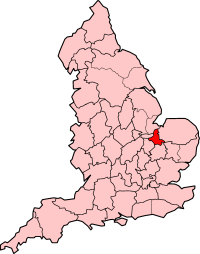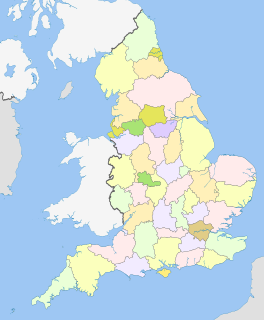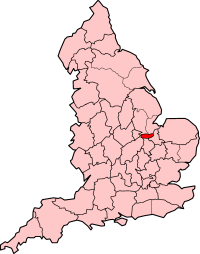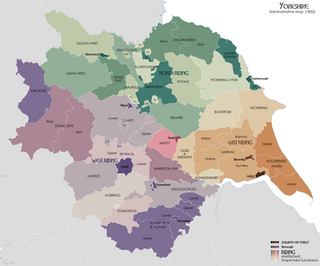Coordinates: 54°08′20″N1°31′26″W / 54.139°N 1.524°W The Liberty of Ripon or Riponshire was a liberty possessing separate county jurisdiction, [1] although situated within the county of Yorkshire, England.

A geographic coordinate system is a coordinate system that enables every location on Earth to be specified by a set of numbers, letters or symbols. The coordinates are often chosen such that one of the numbers represents a vertical position and two or three of the numbers represent a horizontal position; alternatively, a geographic position may be expressed in a combined three-dimensional Cartesian vector. A common choice of coordinates is latitude, longitude and elevation. To specify a location on a plane requires a map projection.
A liberty was an English unit originating in the Middle Ages, traditionally defined as an area in which regalian right was revoked and where the land was held by a mesne lord. It later became a unit of local government administration.

Yorkshire, formally known as the County of York, is a historic county of Northern England and the largest in the United Kingdom. Due to its great size in comparison to other English counties, functions have been undertaken over time by its subdivisions, which have also been subject to periodic reform. Throughout these changes, Yorkshire has continued to be recognised as a geographical territory and cultural region. The name is familiar and well understood across the United Kingdom and is in common use in the media and the military, and also features in the titles of current areas of civil administration such as North Yorkshire, South Yorkshire, West Yorkshire and East Riding of Yorkshire.
The liberty was under the jurisdiction of the Archbishop of York, a privilege claimed to have been granted by King Aethelstan in the 10th century. The liberty was governed by a high steward and justices of the peace, appointed by the archbishop, and the area had separate quarter sessions, in conjunction with the mayor and recorder of the borough of Ripon, in whose town hall they were held.

The Archbishop of York is a senior bishop in the Church of England, second only to the Archbishop of Canterbury. The archbishop is the diocesan bishop of the Diocese of York and the metropolitan bishop of the Province of York, which covers the northern regions of England as well as the Isle of Man. The Archbishop of York is an ex officio member of the House of Lords and is styled Primate of England.

A borough is an administrative division in various English-speaking countries. In principle, the term borough designates a self-governing walled town, although in practice, official use of the term varies widely.

Ripon is a cathedral city in the Borough of Harrogate, North Yorkshire, England. Historically part of the West Riding of Yorkshire, it is located at the confluence of two tributaries of the River Ure, the Laver and Skell. The city is noted for its main feature, Ripon Cathedral which is architecturally significant, as well as the Ripon Racecourse and other features such as its market. The city itself is just over 1,300 years old.
In 1831 the following parishes and townships (locally in the North and West Ridings of Yorkshire) were in the liberty: [2]

The North Riding of Yorkshire is one of the three historic subdivisions (ridings) of the English county of Yorkshire, alongside the East and West ridings. From the Restoration it was used as a lieutenancy area, having been part of the Yorkshire lieutenancy previously. The three ridings were treated as three counties for many purposes, such as having separate quarter sessions. An administrative county was created with a county council in 1889 under the Local Government Act 1888 on the historic boundaries. In 1974 both the administrative county and the Lieutenancy of the North Riding of Yorkshire were abolished, being succeeded in most of the riding by the new non-metropolitan county of North Yorkshire.

The West Riding of Yorkshire is one of the three historic subdivisions of Yorkshire, England. From 1889 to 1974 the administrative county, County of York, West Riding, was based closely on the historic boundaries. The lieutenancy at that time included the City of York and as such was named West Riding of the County of York and the County of the City of York.
- Most of Ripon
- Felixkirk
- Sutton-under-Whitestonecliffe
- Kilburn, North Yorkshire
- Nidd with Killinghall
- Marton-cum-Moxby

Felixkirk is a village and civil parish in the Hambleton District of North Yorkshire, England. The village is situated about three miles north-east of Thirsk. The population of the civil parish was estimated at 100 in 2014.
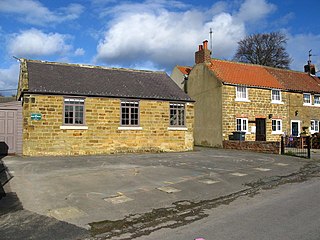
Sutton-under-Whitestonecliffe is a village and civil parish in the Hambleton district of North Yorkshire, England. Historically part of the North Riding of Yorkshire, it is situated on the A170 at the foot of Sutton Bank, about three miles east of Thirsk.

Kilburn is a village in the civil parish of Kilburn High and Low, in the Hambleton district in the county of North Yorkshire, England. It lies on the edge of the North York Moors National Park, and 6.2 miles (10.0 km) north of Easingwold.
In 1836 the temporal jurisdiction of the archbishop was ended, [3] with the power to appoint justices revested in the crown, and in 1837 the townships locally in the North Riding were removed from the liberty. [4]
In 1889, the Local Government Act 1888 came into operation. Section 48 of the Act merged "every liberty and franchise of a county" into its surrounding administrative county. While this was the end of the liberty's administrative functions, separate quarter sessions continued until 1953, [5] and it was also a distinct unit for land tax purposes for some time.

The Local Government Act 1888 was an Act of the Parliament of the United Kingdom, which established county councils and county borough councils in England and Wales. It came into effect on 1 April 1889, except for the County of London, which came into existence on 21 March at the request of the London County Council.
An administrative county was an administrative division in England and Wales and Ireland from 1888 to 1974, used for the purposes of local government. They are now abolished, although in Northern Ireland their former areas are used as the basis for lieutenancy.



